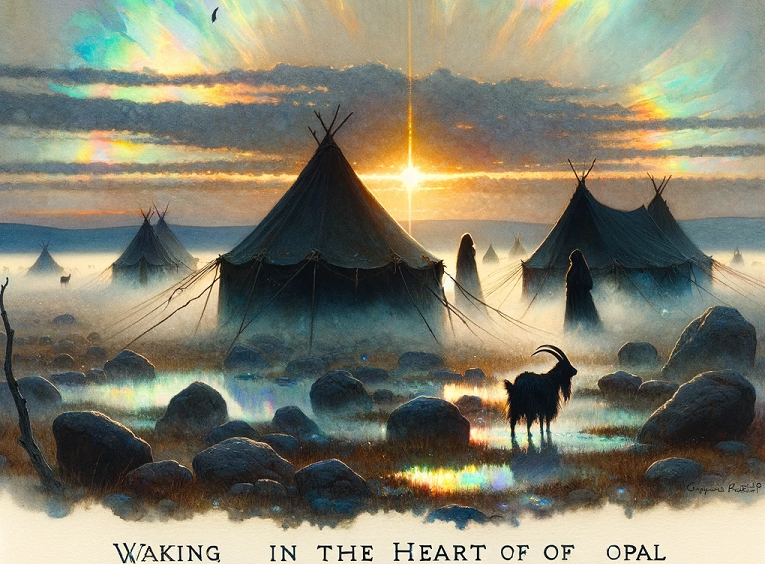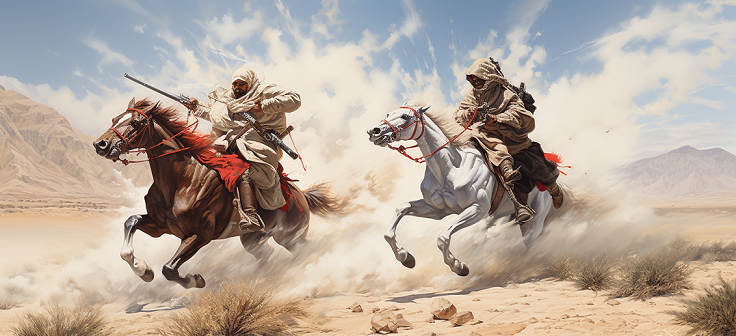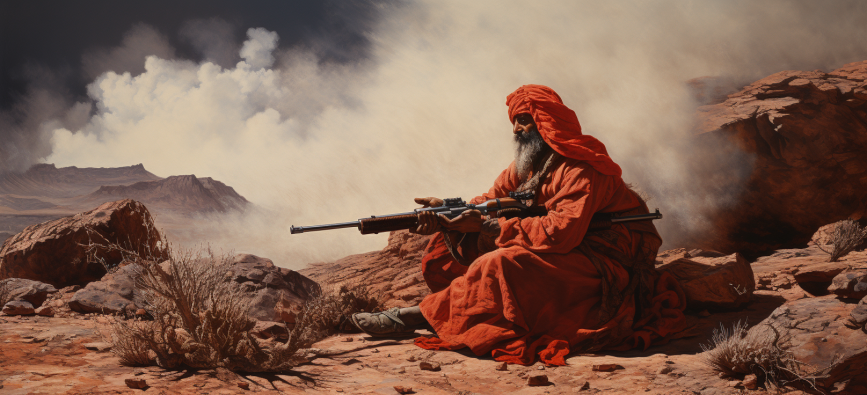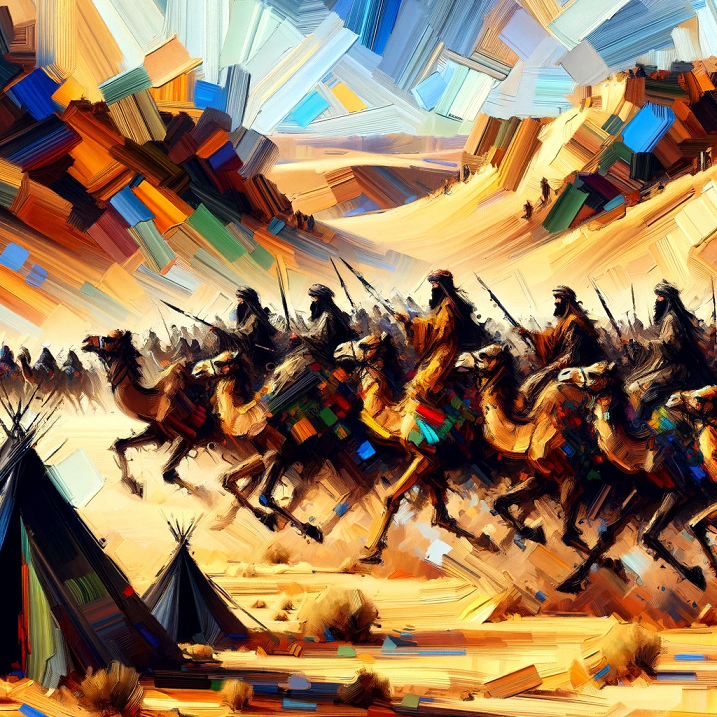In the early 20th century, Gertrude Bell, an intrepid explorer and writer, embarked on a journey through the vast and enchanting Arabian desert. Her captivating narrative takes us on a mesmerising adventure as she and her companions bid farewell to the warmth and hospitality of a welcoming camp and ventured into the heart of the arid expanse.
Bell introduces us to an Arabic proverb that sets the tone for their departure: “Hayyeh rubda wa la daif mudha,” which translates to “neither ash-grey snake nor mid-day guest.” This saying reflects the group’s determination not to overstay their welcome, respecting the customs and manners of their gracious hosts. Before the sun had risen, they meticulously packed up their camp, leaving behind the comforts of a welcoming abode.
As they awoke to the desert dawn, Bell beautifully describes the experience as akin to “waking in the heart of an opal.” The landscape unfolded before their eyes, shrouded in mists and adorned with ethereal dew, casting an enchanting spell on the surroundings. The daybreak brought forth the subtle hues of the eastern sky, which transitioned into the brilliance of the sun’s golden rays.
Amid this natural spectacle, Bell exchanged heartfelt gestures with her hosts. A silver and purple kerchief was sent as a parting gift, intended for “the little son” who had played around the campfire. Gratitude flowed as they took leave of their host, Namrud. A final cup of coffee was shared, and the old sheikh, a symbol of wisdom and guidance, held Bell’s stirrup as she mounted her steed and set off with her trusty guide, Gablan.

Jebel el ‘Alya
Their journey led them to climb the Jebel el ‘Alya, a majestic peak that offered panoramic vistas of the desert. Here, the landscape resembled the English border country but on a grander scale, with sweeping curves and distant horizons. The cold desert air enveloped them, invigorating every sense, and as Bell remarks, “See the desert on a fine morning and die—if you can.” Even the usually stolid mules seemed to be animated by the intoxicating atmosphere.
The glorious cold air intoxicated every sense and set the blood throbbing
Gertrude Bell: The desert and the Sown 1907
Their ascent continued until they reached the summit of the Jebel el ‘Alya, and from this vantage point, the formidable peak known as the Little Heart lay in the north, glistening beneath its snow mantle. As they gazed at this majestic sight, the stage was set for a journey filled with intrigue, encounters, and the unforgiving beauty of the Arabian desert.
Encounters and Stories on the Journey
Gertrude Bell’s path led her into a rolling plain to the north of the Jebel el ‘Alya. Here, the terrain gradually shifted, shedding the soft desert soil for the unforgiving volcanic rocks of the Hauran region. Their travels continued along a winding course, taking them up a gully of lava as they left the last of the Hassaniyyeh encampments behind. The vast, desolate plain stretched out before them, a stark and barren landscape devoid of the signs of human habitation.
Amid this desolation, Bell’s companions began to share tales of the mysterious rujm, ancient stone structures that dotted the landscape. These enigmatic remnants of a distant past served as catalysts for imaginative speculation, stirring the explorers’ minds with questions about the history and purpose of these intriguing stone formations.
However, their attention was soon drawn to a more immediate concern. In the distance, they spotted the scattered encampments of the Hassaniyyeh, a tribe known for their hospitality and their affiliation with the Da’ja, the group to which Bell’s companions also belonged. As they approached, the explorers could see the preparations for a grand feast that was set to take place the following day.
This impending celebration was none other than the Feast of Sacrifice, a significant event in the Islamic calendar. During this festival, pilgrims in Mecca would sacrifice animals as offerings to God, and True Believers across the region would follow suit. The camp buzzed with activity as the Hassaniyyeh readied themselves for the festivities. Towering piles of thorns were gathered to roast camels and sheep, and the tribe’s shirts, fresh from a once-a-year washing, were laid out to dry in the sun.
A Bedouin Tribal Raid
However, the joyous preparations were suddenly overshadowed by grim news. Two riders emerged on the horizon and made their way towards the camp. Gablan, the guide and protector of Bell’s party, went out to meet them and engaged in a sombre conversation. When he returned, his usually jovial countenance had given way to a grave expression.
The news was troubling. Just a day prior, as Bell and her group had journeyed peacefully from Tneib, a devastating event had unfolded. Four hundred horsemen from the Sukhur and the Howeitat tribes had launched a coordinated attack on the plains, targeting an outlying group of the Beni Hassan, the very tribe among whom Bell and her companions now found themselves. The raiders had made off with the Beni Hassan’s tents, along with a staggering two thousand head of cattle.
The situation was a complex one, as Gablan explained. The Da’ja, to which they belonged, maintained a close alliance with the Beni Hassan. In accordance with tribal customs and honor codes, it was expected that they would come to the aid of their allies in times of crisis. Therefore, Gablan expressed that had they arrived just a day earlier, they might have been compelled to join the fray.
It was almost a pity, I thought, that we had come a day too late, but Gablin looked graver still at the suggestion, and said that he would have been forced to join in the fray, yes, he would even have left me, though I had been committed to his charge, for the Da’ja were bound to help the Beni Hassan against the Sukhur.
Gertrude Bell: The desert and the Sown 1907

This news cast a shadow over the festive atmosphere in the Hassaniyyeh camp. The echoes of sorrow could be heard among the tents as Bell and her companions passed through. One particularly poignant image remained etched in their minds—an Arab man, his head bowed in despair, weeping by a tent pole. Everything he possessed had been ruthlessly swept away by the marauding horsemen.
Despite the constant threat of raids, Bell elucidates the unique customs that have developed among the Arabs to cope with these challenges. She notes that when an Arab loses all his worldly possessions to a raid, he does not succumb to despair. Instead, he traverses the desert, sharing his plight with fellow tribesmen. In a display of solidarity, members of the tribe come forward with gifts—a strip of goats’ hair cloth from one, a coffee-pot from another, a camel from a third, and a few sheep from a fourth. Slowly but surely, the dispossessed Arab rebuilds his life, accumulating enough resources to provide shelter and sustenance for his family.
This resilience, Bell observes, is a hallmark of the Arab way of life. It underscores the dichotomy of their existence, where one day they may be the wealthiest individuals in the desert, only to face utter destitution the next. This delicate balance between fortune and misfortune is further compounded by the ever-present risk of raiding parties descending upon their camps, even from hundreds of miles away.
He (the Arab) lives in a state of war, and even if the purest pledges have been exchanged with the neighbouring tribes there is no certainty that a band of raiders from hundreds of miles away will not descend on his camp in the night, as a tribe unknown to Syria, the Beni Awajeh, fell, two years ago, on the lands south-east of Aleppo, crossing three hundred miles of desert, Marduf (two on a camel) from their seat above Baghdad, carrying off all the cattle and killing scores of people.
Gertrude Bell: The desert and the Sown 1907
While the ghazu (raid) may appear horrific to outsiders, it holds a distinct place within the Bedouin way of life—a deeply ingrained and seemingly accepted tradition. Much like other societies may view a segment of their economy, the Bedouin regard the ghazu as an integral part of their existence. It aligns with their values of honour and bravery, offering a platform for showcasing these virtues as they regale in tales of their exploits during the raids. To the Bedouin, the raid embodies not just an economic activity but a means of preserving their cultural heritage and emphasising the significance of valour in their society.
The truth is that the ghazu is the only industry the desert knows and the only game. As an industry it seems to the commercial mind to be based on a false conception of the laws of supply and demand, but as a game there is much to be said for it. The spirit of adventure finds full scope in it—you can picture the excitement of the night ride across the plain, the rush of the mares in the attack, the glorious (and comparatively innocuous) popping of rifles and the exhilaration of knowing yourself a fine fellow as you turn homewards with the spoil.
Gertrude Bell: The desert and the Sown 1907

Amidst the stark expanse of the desert, Gertrude Bell’s travels unravel, painting a vivid picture of the Arabian terrain’s breathtaking beauty and the intricate lifestyle of the Bedouin people. Her journey through a land where raids are ever-present and fortunes are fleeting, as detailed in the literary works of Gertrude Bell, casts light on the Arab people’s resilience and unyielding spirit. The practice of the ghazu, while baffling to those on the outside, is steeped in cultural importance, encapsulating the principles of honor and valor that underpin the Bedouin ethos. Through her compelling narratives, Bell beckons us to acknowledge the contrasting realities of desert life and the formidable perseverance of its inhabitants.

